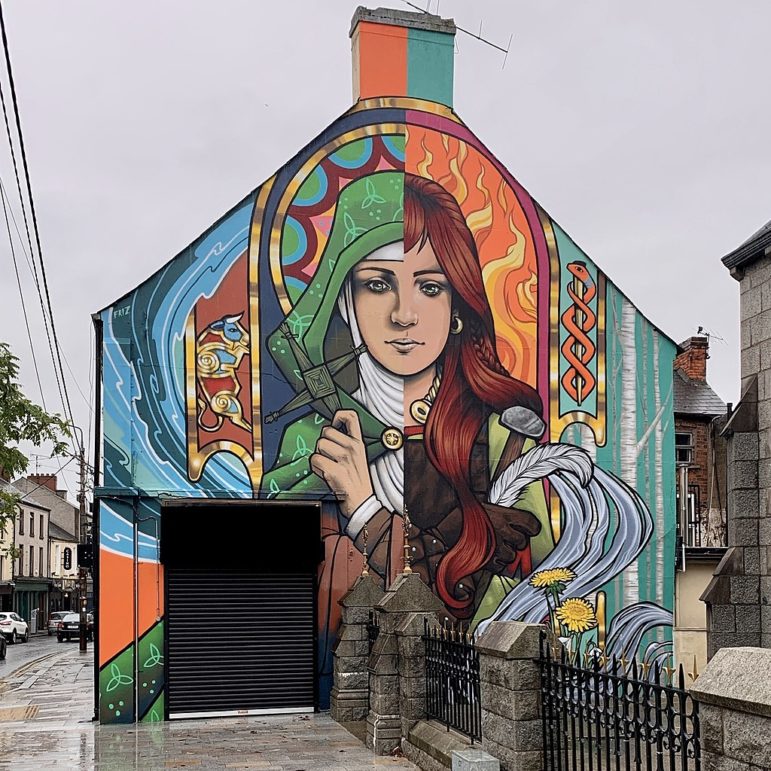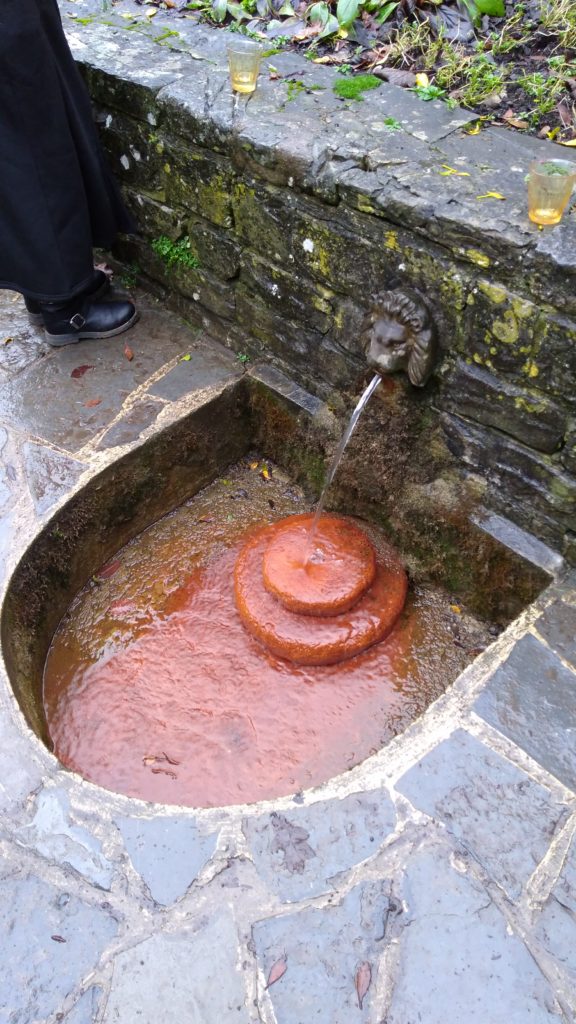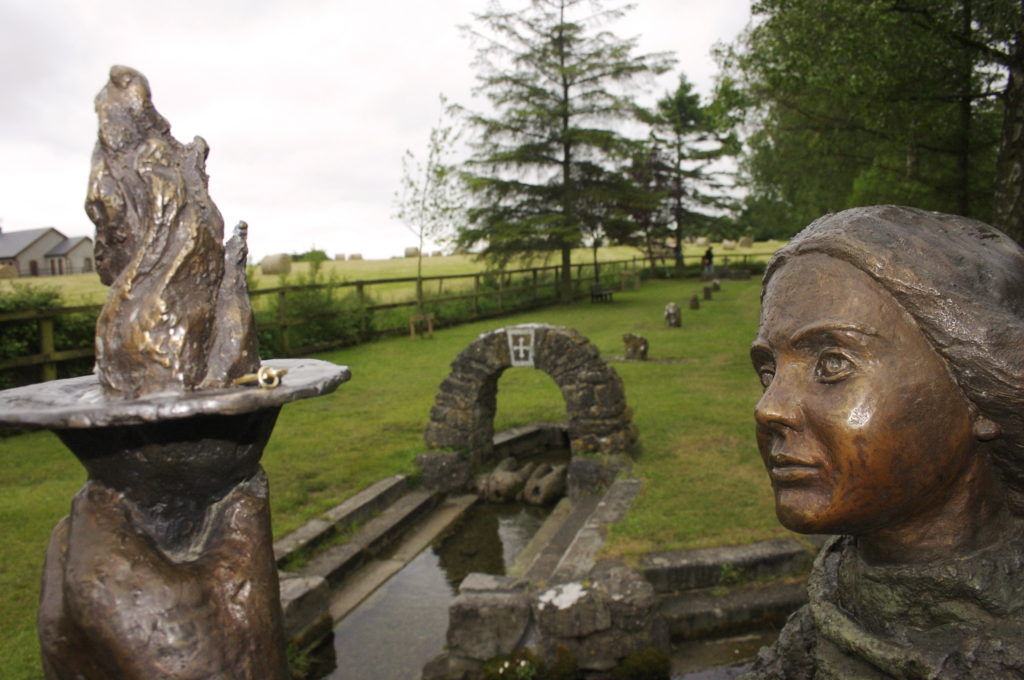TWH – As Pagans know, Imbolc is the festival dedicated to the Goddess Bride (also St. Bridget, who dates from around 450 C.E.): the flame-haired goddess of the forge, of healing, and of poetry. She is accompanied by swans, lambs and snowdrops. Under her name of Brigid, which means ‘fiery arrow,’ she is a deity associated with fire, so candles are lit to welcome her.

St. Bridget and Bride, urban art mural of the Seek Festival, Dundalk, County Louth [DSexton, Wikimedia Commons, CC 4.0]
The name of the festival comes from one of the poems of the Ulster Cycle, in which the heroine Emer mentions ‘Imbolc, when the ewes are milked at spring’s beginning.’ However, etymologists are not certain that this is the origin of the word and it may derive from a much older term.
In Ireland (Éire), Bride is associated with Kildare – there is a shrine to the saint here – and in Britain with Glastonbury, where she is supposed to have resided for a time at a shrine on Bride’s Mound. The local community in Glastonbury thus celebrates her at Imbolc and, after a break for COVID-19, this year saw a true return to form.

The Lion-Head tap at the Chalice Gardens, Glastonbury, UK. (Photo by Eric Scott.)
Celebrations in Glastonbury began at 10.30 a.m. outside the White Spring, a Victorian reservoir complex which has been converted into a water temple and which is run by volunteers from the community. This lies just across the road from the more well-known Red Spring at the Chalice Well. These are both natural springs, emerging from beneath Glastonbury Tor: one is chalybeate, or iron-bearing, and the other, the white spring, contains calcium, hence the names.
A large group of people met in the lane by the gates and were joined by a Shetland pony and the representation of Bride, who, as is customary at this celebration, was a small local girl. It is her choice whether to light the fire pit (under adult supervision!) in the garden of the White Spring in front of the crowd or not and this year the Bride elected to light it once everyone had trooped into the spring complex itself.
Inside, once everyone had assembled, the candles in the temple were extinguished, phones switched off, leaving everyone in pitch darkness. (Photography is not allowed in the White Spring so that the mystery of the place is preserved.) The crowd was encouraged to treat this as an underworld descent, a seed-planting time to set intentions for the year to come. After this had been done, the main temple gates were swung open and the Bride came in, holding a lit candle from which the assembly lit their own tealights.
Within minutes the temple was filled with candlelight. People left their tealights on the ledges around the building and emerged once more into the thin February sunlight to find that the fire pit was roaring away. Some participants chose to follow the pony up onto the slopes of the hill, and others elected to pass through the side gate of the Chalice Well into the gardens – very kindly, the Well had made entry free for the morning.
At this time of year, the Chalice Well garden is full of snowdrops and hellebores, with some early purple crocus also emerging into the sunlight. A meditation was held at the Wellhead, with others choosing to stroll about the gardens themselves.
On the 2nd February the Chalice Well held their own Imbolc ceremony, with a further meditation at the Wellhead at 12 noon.

Brigid’s Well, Kildare [courtesy Star Bustamonte 2006]
In Ireland, a campaign by the feminist group Herstory has resulted in the establishment of Brigid’s Day as a public holiday beginning this year. Una O’Hagan, who co-wrote The Book of St Brigid with her late husband Colm Keane, says:
“Herstory is every woman’s story, and we hope this landmark moment for Mná na hÉireann [the Women of Ireland] will inspire our diaspora worldwide and other countries to join Ireland in celebrating women and girls as we work towards equality for all. On the first day of spring, may we come together in the spirit of the Celtic tradition to plant new seeds for our shared future, and a healthy Mother Earth.”
Light shows have been held across Ireland, from Roscommon to Galway, culminating with a series of events in Kildare, the original home of the saint. The London Embassy of the Republic also joined in, celebrating St. Brigid’s Festival in the Consulate network, plus the Irish Cultural Centre in Hammersmith, the London Irish Centre, and Irish Film London.
We received the following note from Helen Johnson, a Pagan chaplain, about her Imbolc celebrations:
My Imbolc celebration yesterday was at Lewes Prison [in East Sussex, England] in my role as Pagan chaplain. I had six male residents attend. I created a sacred space then we began with a meditation on the three realms, then I spoke for a while about Imbolc and Brigid (interesting in a male prison). Some of the guys had created art work based on what I had previously told them, one had brought milk in as an offering to Brigid, another some oat cakes. I had a Brigid doll, candles and had made a cross -we discussed that this represented the sun. During the ritual we created a negative cycle breaking sigil … which they each took away with them. Invitations were made to Brigid, the ancestors and the spirit of place.
“One resident had created and performed a piece of spoken work about the Oak king and the promise of spring. I asked them all to write down a hope on a piece of paper which we put underneath the bowl with milk in. We had a further guided mediation where in part I asked them to visualise their hope budding then coming to life …. similar to the plants under the ground… and explained that their hopes needed tending to and looking after too. After the ceremony and the residents had returned to the wings I burned the paper with their wishes and added this, the milk and the crumbs of an oatcake to the earth in the ground near the chaplaincy It was really moving and I felt that they all left feeling more positive at least.”
Editorial correction note: Helen Johnson, originally listed as H.C. Johnson in the article, was incorrectly identified with the wrong pronoun, and is no longer affiliated with Life Rites. The article has been updated to reflect these changes.
The Wild Hunt is not responsible for links to external content.
To join a conversation on this post:
Visit our The Wild Hunt subreddit! Point your favorite browser to https://www.reddit.com/r/The_Wild_Hunt_News/, then click “JOIN”. Make sure to click the bell, too, to be notified of new articles posted to our subreddit.
